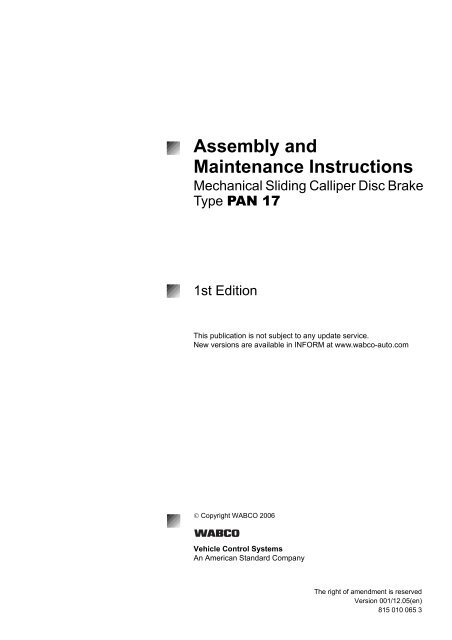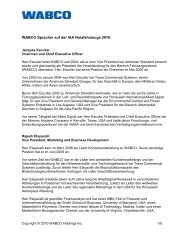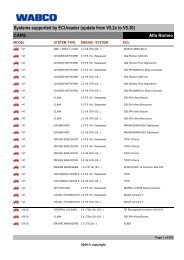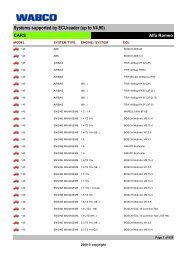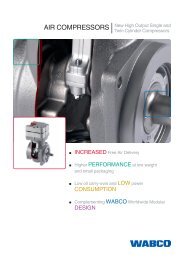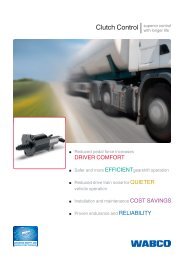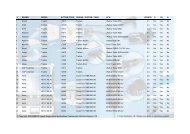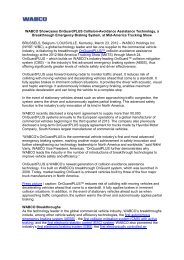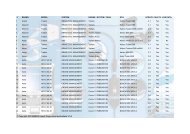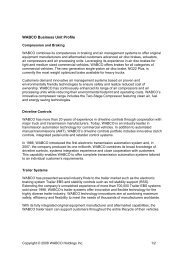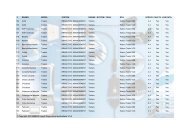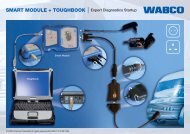Assembly And Maintenance Instructions â WABCO
Assembly And Maintenance Instructions â WABCO
Assembly And Maintenance Instructions â WABCO
You also want an ePaper? Increase the reach of your titles
YUMPU automatically turns print PDFs into web optimized ePapers that Google loves.
<strong>Assembly</strong> and<br />
<strong>Maintenance</strong> <strong>Instructions</strong><br />
Mechanical Sliding Calliper Disc Brake<br />
Type PAN 17<br />
1st Edition<br />
This publication is not subject to any update service.<br />
New versions are available in INFORM at www.wabco-auto.com<br />
8150100653<br />
815 010 065 3<br />
© Copyright <strong>WABCO</strong> 2006<br />
Vehicle Control Systems<br />
An American Standard Company<br />
The right of amendment is reserved<br />
Version 001/12.05(en)<br />
8150200653 815 010 065 3
Table of Contents<br />
1<br />
Page<br />
1. Description of the Mechanical Sliding Calliper Disc Brake 4<br />
1.1 Introduction 4<br />
2. Service <strong>Instructions</strong> 6<br />
2.1 Safety tips during repair 6<br />
2.2 Checking brake function 6<br />
2.2.1 Checking the clearance 7<br />
2.2.2 Checking adjuster function 7<br />
2.3 Checking the brake pads 8<br />
2.4 Checking the brake discs 9<br />
3. Renewing brake pads 10<br />
4. Renewing brake 17<br />
5. Renewing gaiters 18<br />
5.1 Renewing guide pin gaiters and bushes 19<br />
5.2 Renewing adjuster screw gaiter 24<br />
6. Renewing brake cylinder 26<br />
Table 1: Spanner widths [AF] and tightening torques [Nm] 29<br />
Exploded view of the exchange units PAN 17 30<br />
Note:<br />
The Service Instruction focuses on trained specialists. Operations on the brake can only be<br />
carried out if the appropriate paragraphs have been read through and understood. The safety<br />
instructions according to paragraph 2.1 are to be considered and to be followed.<br />
These Service <strong>Instructions</strong> are copyright. All rights reserved.<br />
This publication is not subject to any update service. You will find the latest versions in IN-<br />
FORM under www.wabco-auto.com when quoting the publications number 815 010 065 3.<br />
No part of this publication may be reproduced, stored in a retrieval system, or transmitted in<br />
any form or by any means, electronic, photocopying, recording or otherwise without permission<br />
in writing from <strong>WABCO</strong> Radbremsen GmbH.<br />
3
PAN 17<br />
4<br />
Sliding Calliper Disc Brake<br />
1. Description of the Mechanical Sliding Calliper Disc Brake<br />
1.1 Introduction<br />
The brake PAN is a sliding calliper disc brake. The sliding<br />
calliper disc brake is supposed to be used in commercial<br />
vehicles on front and rear axle as service,<br />
auxiliary and parking brake. It is actuated mechanically<br />
via a diaphragm brake cylinder or a spring brake cylinder.<br />
This is mounted to the end cover of the brake calliper.<br />
A very compact unit is achieved by the direct mounting<br />
of the brake cylinder onto the calliper. This enables optimal<br />
utilisation of the installation situations.<br />
The complete disc brake including brake cylinder consists<br />
of two assemblies:<br />
• Brake calliper (1)<br />
• Brake carrier (2)<br />
The brake calliper (1) moves axially on guide pins (8, 9)<br />
of the brake carrier (2). In the brake carrier the brake<br />
pads (35, 36) are guided and supported axially relocatable.<br />
The fastener of the brake pads works with a hold-<br />
2<br />
1<br />
down hoop (38) and hold-down springs (37) - see pictures<br />
1 to 3.<br />
The radially open design of the brake calliper allows simple<br />
and quick changes of the brake pads.<br />
For compensating the pad wear the actuating mechanism<br />
of the brake is equipped with an automatic adjuster<br />
mechanism. This maintains a predetermined clearance<br />
independend from overall load configuration and different<br />
operating conditions. This, together with a stable<br />
and stiff construction of the brake calliper, results in a<br />
safe control of the pedal travel and increases the distance<br />
reserve for emergency braking.<br />
The internal moving components are lubricated for life<br />
and all sealing components are maintenance free unless<br />
damaged.<br />
The disc brake is equipped with an electrical wear indicator<br />
/ sensor (40).<br />
1<br />
Fig. 1
5<br />
4<br />
8<br />
6<br />
Figure 2: Top view and sectional view<br />
39<br />
Figure 3: Page preview and sectional view<br />
Sliding Calliper Disc Brake PAN 17<br />
22<br />
37 35 38 36 40 19<br />
21<br />
12<br />
1<br />
2<br />
19<br />
10<br />
9<br />
7<br />
21<br />
5
PAN 17<br />
2. Service <strong>Instructions</strong><br />
This instruction with the following pictures contains the<br />
required steps and work sequences to replace the available<br />
repair kits. The spanner size and the tightening torques<br />
in the sequences are listed in table 1 (see page<br />
29).<br />
For lubrication use only the tube of grease supplied with<br />
the <strong>WABCO</strong> brake repair kit.<br />
2.1 Safety tips to be considered during<br />
repair<br />
The flawless technical condition of the disc brake is most<br />
important to ensure goog driving and safe braking characteristics.<br />
6<br />
Observe brake pad and disc wear limits!<br />
Worn-out pads and discs reduce the brake<br />
effectiveness and cause brake failure! Danger<br />
of accidents! Burned, glazed or oil contaminated<br />
brake pads must be replaced<br />
immediately.<br />
Always replace brake pads on a per axle<br />
basis!<br />
During repairs on the brake the vehicle must<br />
be parked on a level surface and blocked to<br />
prevent rollaway. Only approved and suitable<br />
fixtures are to be used for the lifting and<br />
blocking of the vehicle. While working on the<br />
brake ensure that the brake cannot be actuated<br />
inadvertently.<br />
Do not actuate the brake while the brake<br />
pads are removed. Danger of bodily injury!<br />
Do not clean the brake with pressurised air or<br />
other high cleaning pressure apparatus.<br />
Danger of bodily injury! Danger of destruction<br />
of rubber parts!<br />
Keep hands and fingers out of the inside of<br />
the calliper to avoid injury!<br />
Sliding Calliper Disc Brake<br />
A second technican must assist during removal<br />
and installation of the brake. Heavy<br />
load - Danger of bodily injury!<br />
During repairs outside of the vehicle, the<br />
brake must be secured in a fixture, such as a<br />
heavy vise as high torque is required during<br />
removal and installation of the bolts. Large<br />
loosening and tightening torques of the<br />
screw connexions - Danger of bodily injury!<br />
The brake calliper with clamping unit shall not be<br />
opened. Therefore the bolts holding the cover shall not<br />
be loosened.<br />
Only original and genuine <strong>WABCO</strong> Service Parts and<br />
approved brake pads are to be used.<br />
During repairs use only recommended tools. Do not use<br />
a power-driven socket or tools! Tighten nuts and bolts<br />
only to specified torque limits.<br />
With newly installed brake pads emergency stops<br />
should be avoided if possible for the first 50 km. Also<br />
avoid long braking cycles and forced brakings.<br />
When wear of the cast brake parts such as cracks or<br />
heavy abrasion is noticied replace the entire brake assembly<br />
according to the instructions.<br />
Upon completion of repairs the vehicle's braking system<br />
must be tested on a roller dynamometer. If no roller dynamometer<br />
is available a driving test with brake applications<br />
must be perfomed.<br />
2.2 Checking brake function<br />
Important:<br />
Do not use a power-driven socket! While<br />
working at the brake or moving of the<br />
brake calliper handle the calliper only<br />
from outside to avoid injury!
39<br />
Fig. 4<br />
Fig. 5<br />
12<br />
38<br />
1 40 37<br />
Fig. 6 22<br />
Sliding Calliper Disc Brake PAN 17<br />
1<br />
35<br />
2.2.1 Checking the clearance<br />
General note:<br />
The turning directions and the torques for the hexagon<br />
on the adjuster nut are given in table 1, position I. The<br />
actuation cylinder does not need to be removed for this<br />
check.<br />
Work sequences:<br />
• Remove hexagon bolt (39) with spanner SW 17 from<br />
pad hold-down hoop (38).<br />
• Pad hold-down hoop (38) has to be withdrawn from<br />
the calliper (1).<br />
• Remove three hold-down springs (37).<br />
• Push cable guide (40) away to the side.<br />
Note: Brake pads and spreader plate remain installed.<br />
• Push the brake calliper towards the wheel side and<br />
check the clearance with the feeler gauge.<br />
0,5 mm ≤ clearance ≤ 1,2 mm.<br />
Note: Always insert the feeler gauge in the middle of the<br />
brake between brake calliper (1) and brake pad plate<br />
(35).<br />
If the clearance is outside of the limit values, check the<br />
adjuster according to section 2.2.2.<br />
2.2.2 Checking Adjuster Function<br />
Work sequences:<br />
• Remove plug (12) for the adjuster from the calliper.<br />
• With a ring spanner set a clearance of 2 or 3 mm on<br />
the hexagon (22) of the adjuster.<br />
Important: The check of the adjuster is only possible<br />
with a set clearance of 2 to 3 mm.<br />
With the ring spanner mounted on the adjuster nut<br />
ensure that there is sufficient such that it will not be<br />
prevented from turning during the adjuster check.<br />
Do not use an open-ended spanner for the hexagon<br />
(22) of the adjuster. Do not overload the adjuster<br />
hexagon!<br />
7
PAN 17<br />
• Actuate the brake 5 times (approx. 1 bar). The adjuster<br />
is functioning when the ring spanner turns anticlockwise<br />
with every brake actuation.<br />
Note: With increasing adjustment the angular movement<br />
of the attached ring spanner becomes smaller.<br />
The attached ring spanner<br />
a) does not turn.<br />
b) turns only with the first actuation.<br />
c) moves back and forth with every actuation, which<br />
means the adjustment is not OK.<br />
If so, replace the brake according to section 4!<br />
• After checking the adjuster reset the clearance to<br />
1 mm as described in section 3.<br />
• Refit plug (12) and ensure that the plug is placed<br />
properly.<br />
2.3 Checking brake pads<br />
Work sequences:<br />
Note: The brake pad thickness is to be checked regularly<br />
depending on operating conditions during maintenance<br />
intervals and under applicable local laws and<br />
regulations. Burned, glazed or oil contaminated brake<br />
pads must be replaced immediately.<br />
Always replace brake pads on a per axle basis!<br />
Work sequences:<br />
Caution: To avoid damaging the brake disc, replace<br />
the brake pads at the latest, when they reach the<br />
wear limit with their weakest spot.<br />
A = Pad thickness with friction material 9 mm minimum<br />
limit value.<br />
Replace the brake pads according to section 3.<br />
B = Pad thickness new without friction material 19 mm.<br />
C = Total pad thickness with friction material 26 mm.<br />
• After the checks reposition the cable guide (40), insert<br />
the hold-down springs (37) and attach the pad<br />
hold-down hoop (38) with the hexagon bolt (39) to<br />
the brake calliper (for required tightening torque see<br />
table 1, position II).<br />
8<br />
Sliding Calliper Disc Brake<br />
12<br />
22<br />
Friction<br />
material<br />
Fig. 7<br />
Fig. 8<br />
Fig. 9
Fig. 10<br />
Fig. 11<br />
Sliding Calliper Disc Brake PAN 17<br />
With an electrical wear indicator on the brake pads:<br />
When the control display lights up the minimum pad<br />
thickness is reached. Drive to a workshop where the<br />
worn pads can be replaced according to section 3.<br />
2.4 Checking brake discs<br />
Work sequences:<br />
• Remove brake pads according to section 3.<br />
• Measure disc thickness over the rubbing faces.<br />
D = total disc thickness - new 34 mm.<br />
E = wear allowance limit 28 mm, the brake disc must be<br />
renewed.<br />
Important:<br />
Observe brake pad and disc wear limits!<br />
Worn-out pads and discs reduce the<br />
brake effectiveness and cause brake failure!<br />
Danger of accidents!<br />
Always replace brake discs on a per axle basis! Generelly<br />
after the installation of new brake discs we<br />
recommend to replace the brake pads as well.<br />
Brake disc condition inspection:<br />
Check brake disc for cracks, condition of the rubbing<br />
faces and maximum wear dimension.<br />
A= crazing = permissible<br />
B = Radial cracks<br />
to max: 0.5 mm width = permissible<br />
C = unevennedd under 1.5 mm<br />
of the plate surface = permisssible<br />
D = continuous cracks = not permissible<br />
a= braking surface<br />
9
PAN 17<br />
Checking brake disc runout:<br />
• Mount a dial indicator on the brake carrier.<br />
• With the disc installed measure the runout by rotating<br />
the hub as shown in fig. 12. Limit 0.15 mm .<br />
• At higher values renew the disc.<br />
• Install brake pads and set clearence. Carry out according<br />
to section 3 and pay attention to notes.<br />
3. Renewing brake pads<br />
10<br />
Important:<br />
Do not use a power-driven socket. While<br />
moving the brake handle the calliper only<br />
from outside to avoid injury!<br />
Working sequences for removal of pads:<br />
Note: The cable position and their fastening on the<br />
brake might vary depending on the brake model. A usecase<br />
is described here. Therefore it is necessary to pay<br />
attention to the original position of the fastening for the<br />
following reinstallation!<br />
• Loosen the connection (arrow) and unplug.<br />
• Remove hexagon bolt (39) with spanner SW 17 from<br />
pad hold-down hoop (38).<br />
Sliding Calliper Disc Brake<br />
39<br />
38<br />
Fig. 12<br />
Fig. 13<br />
Fig. 14
38<br />
Fig. 15<br />
40<br />
Fig. 16<br />
Fig. 17<br />
Sliding Calliper Disc Brake PAN 17<br />
35, 37 19, 36, 37<br />
19<br />
41<br />
22<br />
1<br />
1<br />
detail<br />
cut-out<br />
12<br />
• Pad hold-down hoop (38) has to be withdrawn from<br />
the calliper (1).<br />
• Remove three hold-down springs (37) from the brake<br />
pads (35 and 36) and the spreader plate (19).<br />
• Remove cable guide (40) and contacts from the<br />
brake pads.<br />
• Remove clip(s) (41) from the calliper (1).<br />
• Remove plug (12) for the adjuster (22) of the calliper<br />
(1).<br />
• De-adjust the brake by rotating the hexagon on the<br />
adjuster nut (22) with a ring spanner as far as it will<br />
go and then release it by approx. 1/4 turn.<br />
Note: The turning direction to de-adjust is to the right,<br />
that means clockwise.<br />
Caution:<br />
When de-adjusting push back the spreader plate<br />
(19) (arrow) by hand to ensure that the pin as torsion<br />
lock for the adjusting screw does not slip out of its<br />
groove. Otherwise the adjuster screw will turn and<br />
thereby damage its gaiter!<br />
11
PAN 17<br />
• Slide the calliper (1) by hand towards the wheel side<br />
(arrow) and remove the brake pad (35).<br />
• Slide the calliper (1) by hand towards the cylinder<br />
side (arrow) and remove the brake pad (36) and the<br />
spreader plate (19).<br />
12<br />
Important:<br />
Do not actuate the brake while the brake<br />
pads are removed.<br />
Danger of bodily injury!<br />
• Using a wire brush remove any corrosion from the<br />
spreader plate, brake pad slot and brake pads guide<br />
surfaces.<br />
Caution:<br />
Take care not to damage the dust caps (5, 10). The<br />
guide surfaces must be free of grease!<br />
Sliding Calliper Disc Brake<br />
35<br />
5<br />
10<br />
36<br />
19<br />
1<br />
Fig. 18<br />
1<br />
Fig. 19<br />
Fig. 20
Fig. 21<br />
Fig. 22<br />
Fig. 23<br />
Sliding Calliper Disc Brake PAN 17<br />
5, 8<br />
5, 9<br />
10, 21<br />
Checking the dust caps (gaiters) and the brake<br />
calliper movement:<br />
• Slide the calliper towards the side to allow examination<br />
of the gaiters (5, 10), the guide pins (8, 9) and the<br />
adjuster screw (21) for wear and damage. Renew<br />
defective gaiters (see section 5.1 and 5.2)!<br />
Caution:<br />
In case of a defective the gaiter (10) must be<br />
checked if dirt or water has already entered or damaged<br />
the inner parts of the brake or the gaiter seat in<br />
the calliper by corrosion. In case of doubt the brake<br />
must be renewed according to section 4. If the gaiter<br />
(10) is damaged while the brake is serviced, the gaiter<br />
must be renewed according to section 5.2.<br />
• Slide the calliper on the guide pins by hand over its<br />
total displacement and check for freedom of movement.<br />
If the movement is restricted renew the<br />
guide pins bushes and gaiters according to section<br />
5.1<br />
Caution:<br />
Do not squeeze the dust caps of the guide pins<br />
against the torque plate!<br />
• Checking the adjuster according to section 2.2.2.<br />
Caution:<br />
Secure the adjuster nut during checking and turning<br />
on the hexagon from twisting, e.g. by holding the pin<br />
(see arrow).<br />
• Checking the brake discs according to section 2.4.<br />
13
PAN 17<br />
Working sequence for pad installation:<br />
• Slide the calliper until there is sufficient space between<br />
the actuation side and the disc to insert the<br />
brake pad.<br />
• Insert spreader plate (19) in the brake carrier and engage<br />
with the adjuster screw (21).<br />
Important:<br />
The spreader plate always has to be placed in the guideway<br />
(arrow) of the brake carrier correctly and overlie the<br />
entire surface of the guide bar of the brake carrier. Otherwise<br />
the spreader plate might slide out of the guiding.<br />
If necessary, move the callipar a little towards the wheel<br />
side! The pin of the adjuster nut has to engage with the<br />
groove of the spreader plate. Otherwise the function of<br />
the adjuster mechanism is not ensured! The adjuster<br />
screw can be turned to obtain alignment. The gaiter may<br />
not be twisted!<br />
• New brake pad (36) has to be inserted on the actuating<br />
side<br />
• Slide the calliper toward the wheel until the brake pad<br />
(36) contacts the disc.<br />
• New brake pad (35) has to be inserted on the wheel<br />
side.<br />
• Using a 1 mm thick feeler gauge (arrow) inserted between<br />
the backing plate of the brake pad on the<br />
wheel side and the brake calliper, turn the hexagon<br />
(22) of the adjuster nut with a ring spanner until both<br />
brake pads contact the brake disc.<br />
Note: Insert the feeler gauge approx. in the middle of the<br />
brake pad between the contact surface and the brake<br />
calliper. The turning direction to adjust the break is to the<br />
left, that means anti-clockwise. Do not fit pad hold-down<br />
hoop before adjusting air gap.<br />
Caution:<br />
Do not overload the adjuster hexagon (22)!<br />
14<br />
Sliding Calliper Disc Brake<br />
35<br />
36<br />
19, 21<br />
Fig. 24<br />
Fig. 25<br />
22<br />
Fig. 26
Fig. 27<br />
Fig. 28<br />
Fig. 29<br />
Fig. 30<br />
40<br />
Sliding Calliper Disc Brake PAN 17<br />
37, 35<br />
37,19,36<br />
38<br />
• Place the new pre-assembled wear indicators and<br />
the cable guide (40) on the calliper and insert the<br />
sensor contact (see arrows) into the brake pads.<br />
Important:<br />
The cable side of the sensor contacts need to point towards<br />
the brake disc and the sensor contact needs to be<br />
inserted in the brake pad correctly!<br />
• Position cable guide and cable exit of the wear indicators<br />
on the brake calliper.<br />
Caution:<br />
Twist and position the cable wrappings on the actuation<br />
side, so that no cable touches the brake pad.<br />
• Put the three new hold-down springs (37) on the<br />
brake pads (35 and 36) and the spreader plate (19).<br />
• Slide new hold-down hoop (38) through opening in<br />
the cable guide and openings in the brake calliper,<br />
then push downward so that the radial corners of the<br />
hold-down springs snap into the hold-down hoop.<br />
15
PAN 17<br />
• Fit the new hexagon bold (39) to the brake calliper<br />
(tightening torque see table 1, position II) with spanner<br />
SW 17.<br />
• If available, remove the transport protection cap (arrow)<br />
from the plug connection of the wear indicator.<br />
• Insert the new clip (41) in the brake calliper and inlay<br />
the cable inside.<br />
• Plug in the plug of the wear indicator in the connector<br />
coupling (arrow).<br />
• Visually check the correct cable position.<br />
• Fit the new plug (12) to the opening in the brake calliper!<br />
Check and make sure the correct seat!<br />
• Ensure that the wheel hub turns freely.<br />
Caution:<br />
Upon completion test the brakes on the roller dynamometer!<br />
16<br />
Sliding Calliper Disc Brake<br />
39<br />
12<br />
41<br />
Fig. 31<br />
Fig. 32<br />
Fig. 33
4. Renewing brake<br />
Important:<br />
Do not use a power-driven socket! While<br />
working at the brake or moving of the<br />
brake calliper handle the calliper only<br />
from outside to avoid injury!<br />
Note: The new brake is supplied as a pre-assembled<br />
unit and may be mounted to the vehicle's axle via the<br />
brake carrier. Do not exchange left brake (fig. A) and<br />
right brake (fig. B) on the axle! Identify the correct<br />
placement of the brakes on the left or the right side<br />
of the axle through the position of the hold-down<br />
hoop (38) and the hexagon bolt (39) in the brake.<br />
Fig. 34<br />
V<br />
Fig. A<br />
Sliding Calliper Disc Brake PAN 17<br />
M<br />
Rotating direction of the brake<br />
disc driving forward<br />
Brake disc trailing side<br />
38 38<br />
Use the following scheme: The retaining opening in<br />
the calliper for the hold-down hoop (38) and the thread<br />
opening in the calliper for the hexagon bolt (39) are always<br />
relocated for an offset V compared with the axle M<br />
in the middle of the brake in the rotating direction of the<br />
brake disc driving forward towards brake disc trailing<br />
side.<br />
M<br />
Fig. B<br />
Work sequences for brake removal:<br />
• Remove brake pads according to section 3.<br />
• Remove brake cylinder from brake calliper according<br />
to section 6.<br />
• Dismantle the calliper with the carrier from the axle<br />
(see table 1, position III).<br />
• Check brake disc according to section 2.4.<br />
• The removed brake pads must be tested for wear according<br />
to section 2.3.<br />
V<br />
17
PAN 17<br />
Work sequences for installing brake:<br />
• Remove the transportation lock from the new brake<br />
calliper.<br />
• Place the brake with the brake carrier over the brake<br />
disc and mount on the axle. Thighten hexagon bolts<br />
with spanner (table 1, position III).<br />
Note: Observe vehicle manufacturer's special assembly<br />
instructions when assembling brakes.<br />
• Remove the transport protection cap from the cylinder<br />
flange on the brake calliper.<br />
• Refit brake pads and sprader plate according to section<br />
3.<br />
• Refit the brake cylinder on the calliper according to<br />
section 6.<br />
Caution:<br />
With the brake cylinder in its installed position, ensure<br />
that the lower drainage hole facing the ground is open!<br />
All other holes must be plugged!<br />
5. Renewing gaiters<br />
18<br />
Important:<br />
Do not use a power-driven socket! While<br />
working at the brake or moving of the<br />
brake calliper handle the calliper only<br />
from outside to avoid injury!<br />
Note: When replacing all of the gaiters in the calliper,<br />
the work sequences 5.1 and 5.2 are to be combined. In<br />
this case work sequences do not need to be repeated<br />
several times.<br />
When replacing individual gaiters, follow the corresponding<br />
work sequences of the sections 5.1 and 5.2.<br />
Sliding Calliper Disc Brake<br />
Fig. 35<br />
Fig. 36
Fig. 37<br />
Fig. 38<br />
2<br />
Fig. 39<br />
6<br />
11<br />
F<br />
Sliding Calliper Disc Brake PAN 17<br />
1<br />
2<br />
8, 9<br />
7<br />
1<br />
5.1 Renewing guide pin gaiters and<br />
bushes<br />
Important:<br />
The position of the guide pins in the brake may vary depending<br />
on the case of operation. An example of installation<br />
with a long guide pin (8) (plug gauge) driving forward<br />
on the brake disc leading side is shown here. The<br />
renewal can also be carried out with a shorter guide pin<br />
(9) (clearance fit) on the brake disc trailing side.<br />
Working sequences for removal:<br />
• Remove brake pads according to section 3.<br />
• Remove brake cylinder from brake calliper according<br />
to section 6.<br />
• Dismantle the calliper with the carrier from the axle<br />
according to section 4.<br />
• Dismantle brake calliper (1) from brake carrier (2) by<br />
removing sealing caps (11) of the guide pins (8, 9)<br />
from the calliper (1) with a suitable tool, e.g. chisel.<br />
Caution:<br />
Take care not to damage cover bores in calliper.<br />
Position the proper tool on the cover.<br />
• Release the screws (6, 7) with a spanner (table 1, position<br />
IV) and separate the calliper (1) from the carrier<br />
(2).<br />
Important:<br />
Moving brake calliper: danger of bodily injury!<br />
• Clean the mating surfaces (collars) of the carrier (2).<br />
19
PAN 17<br />
• Remove the guide pins (8, 9) from the brake calliper<br />
(1) and the gaiters (5) from the ring groove.<br />
• Place the calliper (1) on a firm base to push out the<br />
bushes (4), so that the calliper opening is facing upwards.<br />
For replacing the bushes use the tools from <strong>WABCO</strong><br />
tool box 12 851 022 and pay attention to the detailed<br />
mounting instructions in the tool box.<br />
• Press the bushes out of the brake calliper using<br />
press and mandrel (tool 1 and 5).<br />
• Clean the bores in the calliper.<br />
20<br />
Sliding Calliper Disc Brake<br />
4<br />
9, 5 8, 5<br />
1<br />
Fig. 40<br />
4<br />
Fig. 41<br />
Fig. 42<br />
Fig. 43
Fig. 44<br />
Fig. 45<br />
Fig. 46<br />
Sliding Calliper Disc Brake PAN 17<br />
Working sequence for installation:<br />
Press in two new bushes for the longer guide pin.<br />
• First press in the inner bush with mandrel (tool 1 and<br />
3) as far as the mandrel will go.<br />
• Then press in the outer bush with mandrel (tool 1 and<br />
6) as far as the mandrel will go.<br />
• Grease the bushes and the space between them.<br />
• Push in a new bush for the shorter guide pin with<br />
mandrel (tool 1 and 4) as far as the mandrel will go.<br />
• Grease the bush.<br />
21
PAN 17<br />
• Push new gaiters (5) in the sealing seats (ring<br />
groove) of the brake calliper (1).<br />
Note: Clean gaiter seats before fitment. The sealing<br />
seats must be free of grease. It is possible to fit the gaiters<br />
by hand. Ensure that the gaiter lip in the annular<br />
groove in the calliper sits free of folds!<br />
• Grease the sliding surface for the guide pins (8, 9).<br />
• Insert new guide pins into the calliper (1).<br />
• Assamble guide pins with gaiters (5) and insert them<br />
into the guide pin seat (8, 9).<br />
Caution:<br />
On this brake model the longer guide pin is located<br />
(8) on the brake disc leading side as a close fit. The<br />
shorter guide pin (9) is a clearence fit and is located<br />
at the brake disc trailing side.<br />
This description also applies in principle for the assembling<br />
of a shorter guide pin as a clearance fit on<br />
the brake disc leading side.<br />
Remove all exess grease. The brake carrier end of<br />
the guide pins and the mating surfaces of the carrier<br />
must be freee of grease!<br />
• Place the calliper (1) on the carrier (2) and insert the<br />
guide pins (8, 9) into the collars in the carrier.<br />
• Insert new bolts (6) (long for close fit pin 8), (7) (short<br />
for clearance fit pin 9) into the guide pins in the brake<br />
calliper (1) and srew with spanner (see table 1, position<br />
IV) on the carrier (2).<br />
Caution:<br />
Do not damage the gaiters (5) during the assembly.<br />
Firstly, always tighten the bolt for the close fit longer<br />
pin (8), followed by the bolt for the clearance fit<br />
shorter pin (9).<br />
If during the maintenance work the guide pin (8 and<br />
9) fastening to the carrier (2) is loosened, then new<br />
bolts (6 and 7) must be used when reasssembling!<br />
22<br />
Sliding Calliper Disc Brake<br />
8<br />
5 5<br />
9, 5 8, 5<br />
6<br />
7<br />
Fig. 47<br />
Fig. 48<br />
9<br />
Fig. 49
Fig. 50<br />
11<br />
Fig. 51<br />
Fig. 52<br />
Fig. 53<br />
Sliding Calliper Disc Brake PAN 17<br />
F F<br />
5<br />
9<br />
8<br />
11<br />
1<br />
• Move brake calliper backwards and forwards on<br />
guide pins (8, 9) several times. Check for ease of<br />
movement.<br />
Caution:<br />
Do not squeeze the dust caps of the guide pins<br />
against the torque plate!<br />
• Grease the boreholes for the covers (11) in the brake<br />
callipers (1).<br />
• Insert new gaiters (11) in the bores of the calliper (1)<br />
and press in with tool 2 from <strong>WABCO</strong> toolbox 12<br />
851 022 as far as it will go.<br />
Note: Take care to avoid damaging the covers.<br />
• For air pressure equalisation lift the gaiters (5) in the<br />
range of the ring groove and reinsert them.<br />
• Place the brake with the brake carrier over the brake<br />
disc and mount on the axle. Thighten hexagon bolts<br />
with spanner (tightening torque see table 1, posttion<br />
III).<br />
Note: Observe vehicle manufacturer's special assembly<br />
instructions when assembling brakes.<br />
• Install brake pads and set clearence. Carry out according<br />
to section 3 and pay attention to notes.<br />
• Before refitting the brake cylinder clean the mounting<br />
flange on the calliper and grease the concave seat<br />
(arrow) in the brake lever.<br />
• Refit the brake cylinder on the calliper according to<br />
section 6.<br />
Caution:<br />
With the brake cylinder in its installed position, ensure<br />
that the lower drainage hole facing the ground<br />
is open! All other holes must be plugged!<br />
23
PAN 17<br />
5.2 Renewing adjuster screw gaiter<br />
Note: If the gaiter only is to be renewed it is not necessary<br />
to dismantle the brake calliper and cylinder.<br />
Working sequences for removal:<br />
• Remove brake pads and spreader plate according to<br />
section 3.<br />
• Pull brake calliper to actuation / cylinder side by<br />
hand.<br />
• Pull the gaiter (10) out the annular groove in the adjuster<br />
screw (21).<br />
• Remove the gaiter from the seat in the brake calliper<br />
by means of a screwdriver.<br />
• Check the adjuster screw thread.<br />
Note: For this purpose refit the wheel side brake pad so<br />
that the adjuster screw cannnot be screwed completely<br />
out of the adjuster. After the thread check remove the<br />
brake pad.<br />
• Secure adjuster screw (21) against turning (arrow)<br />
and screw out the adjuster screw approx. 30 mm by<br />
turning the adjuster hexagon in the anti-clockwise direction<br />
with a ring spanner.<br />
• Examine the thread for corrosion and damage whilst<br />
screwing out.<br />
Caution:<br />
The gaiter (10) can be renewed, if definitely no dirt or<br />
water has penetrated into the brake calliper, or if the<br />
gaiter has been directly damaged during servicing<br />
the brake. In case of doubt the brake must be replaced<br />
according to section 4, if internal parts are<br />
corroded.<br />
• After examination grease the thread and partly screw<br />
back the adjuster screw in clockwise sense.<br />
24<br />
Sliding Calliper Disc Brake<br />
21<br />
10<br />
Fig. 54<br />
Fig. 55<br />
Fig. 56<br />
Fig. 57
Fig. 58<br />
Fig. 59<br />
Fig. 60<br />
Fig. 61<br />
Sliding Calliper Disc Brake PAN 17<br />
21 10<br />
10<br />
1<br />
10<br />
Working sequence for installation:<br />
• Clean the gaiter seat (10) (arrow) in the calliper (fig.<br />
without adjuster screw).<br />
• Push new gaiter (10) over the adjuster screw, centre<br />
it and push down the gaiter into the seat of the calliper<br />
(1) manually (fig. without adjuster screw).<br />
• Grease the gaiter lips (10) and insert the gaiter (10)<br />
into the seat of the adjuster screw (21).<br />
• Visually check gaiter for proper seat.<br />
Note: Ensure that the gaiter lip in the annular groove in<br />
the adjuster screw sits free of folds!<br />
• Install brake pads and set clearence. Carry out according<br />
to section 3 and pay attention to notes.<br />
25
PAN 17<br />
26<br />
6. Renewing brake cylinder<br />
Important:<br />
Do not use a power-driven socket! While<br />
working at the brake or moving of the<br />
brake calliper handle the calliper only<br />
from outside to avoid injury!<br />
Note: Only use cylinders as specified by vehicle manufacturer.<br />
Detailed assembly and check instructions have to be<br />
used according to the cylilnder type and the instructions<br />
of the cylinder manufacturer.<br />
Working sequences for removal:<br />
• Make sure that the brake hoses are pressureless.<br />
• Disconnect air line to cylinder (according to cylinder<br />
manufacturer's data).<br />
• Remove brake cylinder from calliper by releasing cylinder<br />
nuts (table 1, position V).<br />
Working sequence for installation:<br />
Caution:<br />
With the brake cylinder in its installed position, ensure<br />
that the lower drainage hole facing the ground<br />
is open!<br />
• Before refitting the brake cylinder clean the mounting<br />
flange on the calliper and grease the concave seat<br />
(arrow) in the brake lever.<br />
• Fit brake cylinder to the calliper and tighten nuts<br />
crossed using a spanner (table 1, position V). Screw<br />
brake hose to brake cylinder.<br />
Note: The brake hose must not be twisted or lacated<br />
such that it will rub against anything! The brake hose of<br />
the air supply is not allowed to have an influence on the<br />
moveability of the brake calliper.<br />
• Check air connection of the device for tightness.<br />
• Carry out function and effectiveness check. Pay attention<br />
to the regulations of the cylinder manufacturer!<br />
Sliding Calliper Disc Brake<br />
Fig. 62<br />
Fig. 63<br />
Fig. 64
Fig. 65<br />
Fig. 66<br />
Fig. 67<br />
Sliding Calliper Disc Brake PAN 17<br />
Work sequences for spring brake cylinder removal:<br />
• Secure vehicle against rolling.<br />
• Loosen hand brake.<br />
• Screw out release mechanism.<br />
• Apply hand brake.<br />
Caution: Brake hose connection 12 = pressureless<br />
• Mark both brake hoses for proper assembly.<br />
• Screw brake hoses out of the connection.<br />
Caution:<br />
Do not remove brake cylinder with screwed on brake<br />
hoses. Brake hoses might be damaged!<br />
• Dismantle the brake cylinder from the calliper. To do<br />
this, loosen the hexagon bolts and take off the the<br />
brake cylinder (table 1, position V).<br />
Work sequences for spring brake cylinder assembly:<br />
Caution:<br />
With the brake cylinder in its installed position, ensure<br />
that the lower drainage hole facing the ground<br />
is open!<br />
• Before refitting the brake cylinder clean the mounting<br />
flange on the calliper and grease the concave seat<br />
(arrow) in the brake lever.<br />
27
PAN 17<br />
• Fit brake cylinder to the calliper and tighten nuts<br />
crossed using a spanner (table 1, position V).<br />
• Screw both brake hoses to brake cylinder. Pay attention<br />
to the regulations of the cylinder manufacturer!<br />
Important: Pay attention to the correct connections!<br />
Connection 11 = foot brake.<br />
Connection 12 = hand brake.<br />
• Loosen hand brake.<br />
• Screw in release mechanism.<br />
Note: The brake hoses must not be twisted or located<br />
such that they will rub against anything. The brake hoses<br />
of the air supply iare not allowed to have an influence<br />
on the moveability of the brake calliper.<br />
• Check air connection of the device for tightness.<br />
• Carry out function and effectiveness tests (according<br />
to cylinder manufacturer's data).<br />
28<br />
Sliding Calliper Disc Brake
Table 1: Tightening torques<br />
Position Name<br />
Spanner width<br />
[AF]<br />
External<br />
Hexagon<br />
Internal<br />
I Hexagon adjuster 8 X –<br />
II<br />
Screw / Pad hold<br />
down pin<br />
III Brake fixation – X –<br />
IV<br />
V<br />
Coupling guide<br />
pin<br />
Coupling brake<br />
cylinder<br />
Sliding Calliper Disc Brake PAN 17<br />
Tightening torque:<br />
[Nm]<br />
Turning direction of the hexagon:<br />
• Adjust, anti-clockwise (left) maximum 3,<br />
clearance decreases.<br />
• De-adjust, clockwise (right), maximum<br />
12, clearance increases.<br />
Caution:<br />
Do not use a power-driven socket!<br />
17 X – 20 ± 2<br />
14 – X<br />
– X –<br />
Please pay attention to special assembly<br />
instructions and if applicable to wrench size of<br />
the vehicle manufacturer!<br />
340 ± 20<br />
Tightening order for guide pins:<br />
1. 1. Close fit pin (long internal hexagon bolt)<br />
2. 2. Clearence fit pin (short internal hexagon<br />
bolt)<br />
Please pay attention to special assembly<br />
instructions and if applicable to wrench size of<br />
the cylinder manufacturer!<br />
29
PAN 17<br />
Exploded view of the exchange units:<br />
40<br />
30<br />
10<br />
41<br />
Key:<br />
1<br />
5<br />
39<br />
38<br />
Sliding Calliper Disc Brake<br />
1 Brake calliper with brake carrier (not shown) 12 Plug<br />
4<br />
9<br />
4 Bushes for guide pins 35 Brake pad wheel side with wear indicator<br />
5 Gaiters for guide pins 36 Brake pad actuation side with wear indicator<br />
6 Internal hexagon bolt (long) 37 Hold-down springs<br />
7 Internal hexagon bolt (short) 38 Pad hold down pin<br />
8 Guide pin (long) 39 Hexagon Bolt<br />
9 Guide pin (short) 40 Cable guide with wear indicator<br />
10 Gaiter for adjuster screw 41 Clip<br />
11 Cover plate<br />
7<br />
35<br />
11<br />
36<br />
8<br />
6<br />
37<br />
12


